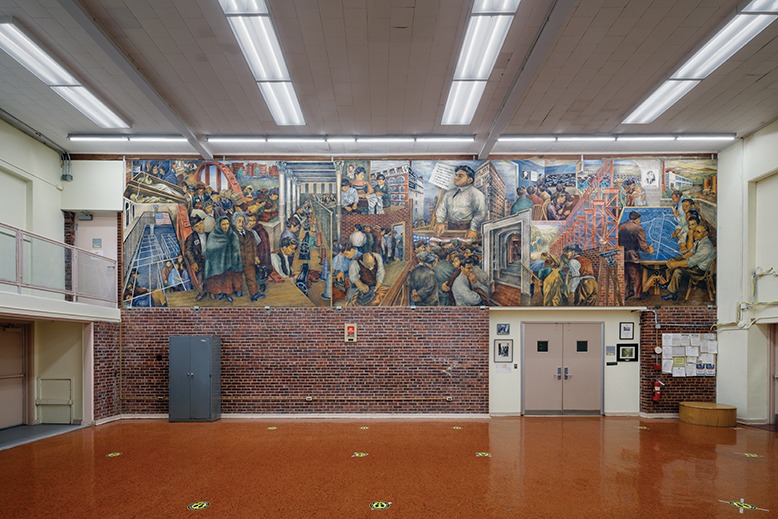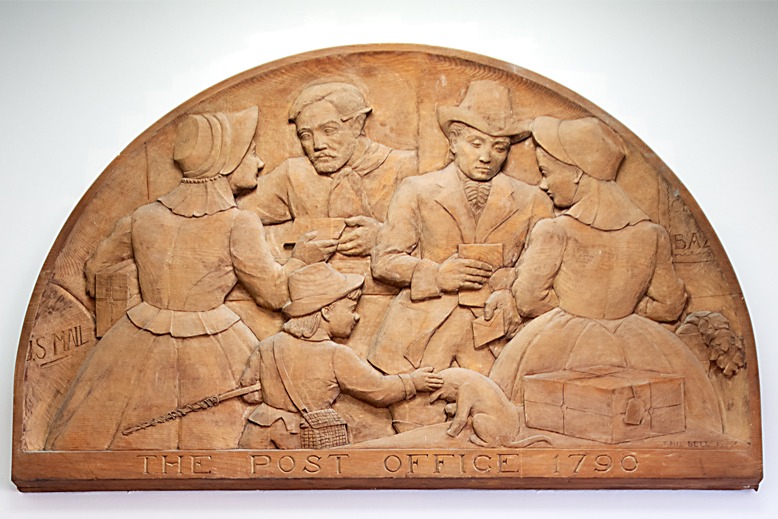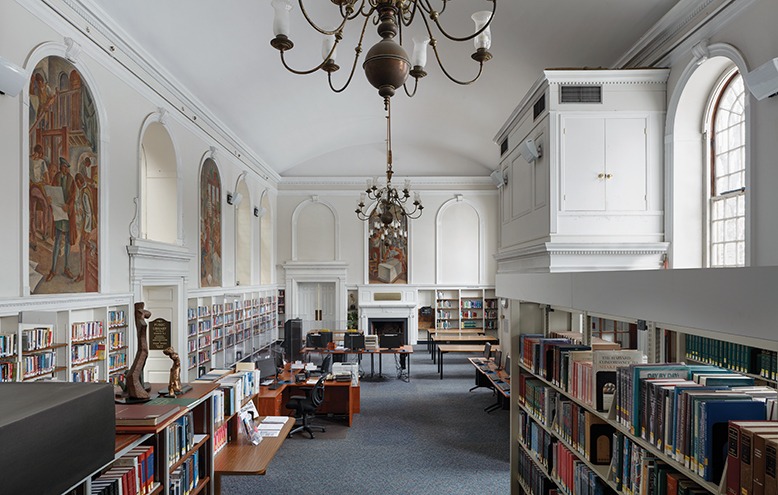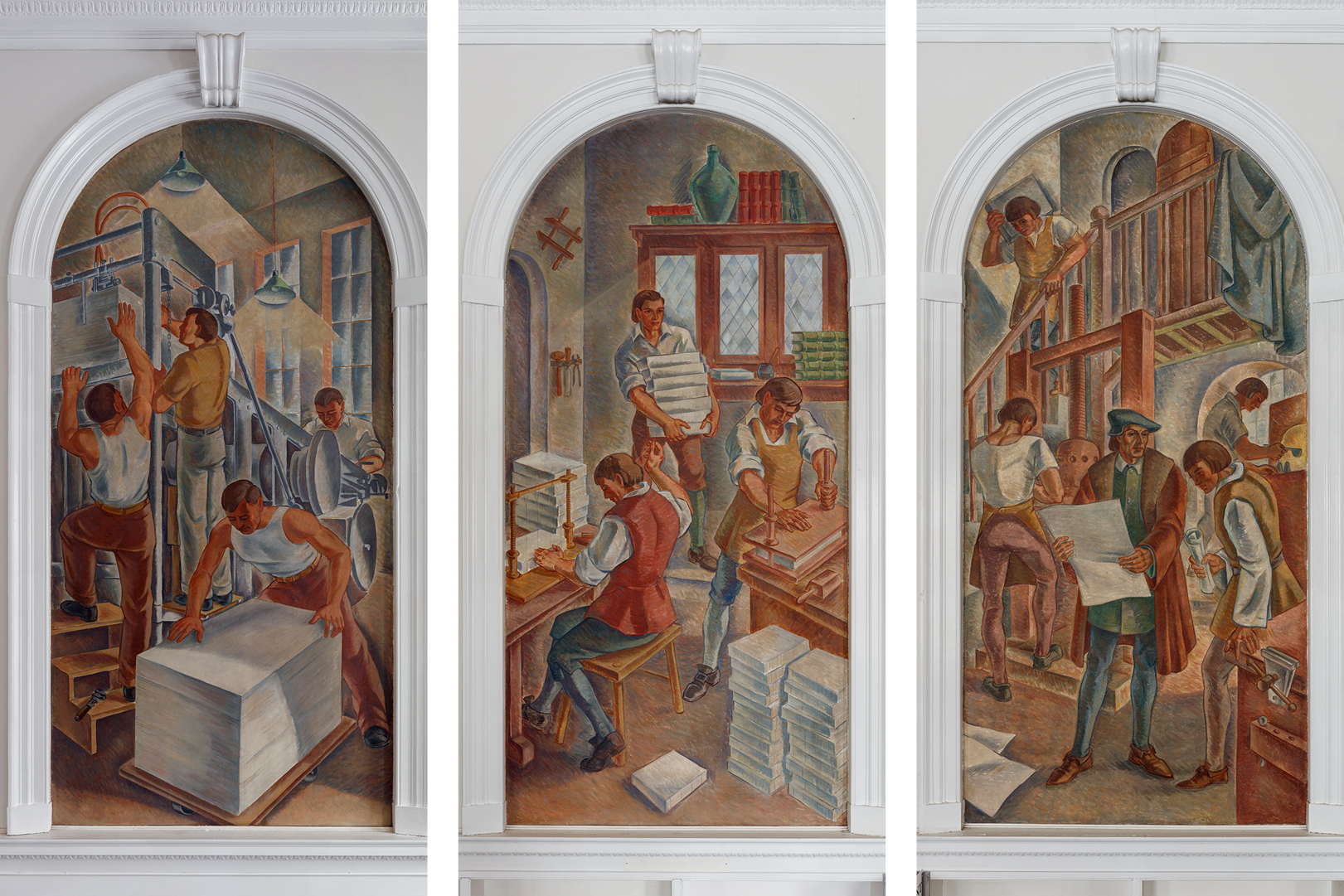
Ben Shahn’s Jersey Homesteads mural. Photo by Colin Miller
Universally hailed as one of the most important American artists of the 20th century, Ben Shahn made paintings, posters and photographs that are exhibited in museums and galleries around the world. Quite remarkably, one of the Lithuanian-born social realist’s most famous works, a colorful, 45-foot-wide mural depicting the Jewish immigrant experience and the American labor movement, can only be seen on the wall of a tiny public school with 73 students in the Monmouth County borough of Roosevelt.
Shahn’s famous fresco, known as the Jersey Homesteads mural, was among the thousands of works commissioned nationwide under New Deal arts programs. From late 1933 to 1943, Franklin Delano Roosevelt’s administration offered work-relief support to more than 10,000 artists struggling with financial hardship. In New Jersey, New Deal art beautified more than 60 towns throughout the state. Much of New Jersey’s New Deal art remains on public view in post offices, libraries, schools, parks, courthouses and other civic spaces. These works—a selection of which are described in this article—comprise an underappreciated legacy for the state.
For many Depression-era artists, a New Deal commission meant professional survival. In December 1933, Edward Bruce, who oversaw federal fine arts projects, underscored the government’s intent: “We are putting artists to work and not trying to make artists out of bums.” Artists appreciated that they had not been forgotten; the arts programs acknowledged them as part of the national labor force.
The ambitious arts programs of the New Deal were, indeed, a big deal. Appropriately, New Deal art was not just for the privileged, but accessible to all. And because the artists could portray a broad range of subject matter, they created everything from glorified historical scenes to realistic depictions of contemporary life and Depression-era hardship.
The arts initiative was part of Roosevelt’s Works Progress Administration (WPA) and several other government-sponsored programs, including the Section of Fine Arts (later the Treasury Relief Art Project). The Section arranged open competitions for artworks designated for publicly funded buildings, while the WPA provided a weekly paycheck for artists working in studios. This included, for example, a glassblowing initiative in South Jersey.
It’s unclear precisely how much publicly financed art was created under the New Deal. “We do not have an accounting of the total amount of federal funding dedicated to the programs, nor do we know the number of artworks created,” acknowledges Jennifer Gibson, director of art in architecture and fine arts programs at the General Services Administration in Washington, D.C. Moreover, there is no definitive breakdown by state.

Englewood artist Enid Bell’s wood relief in the Mount Holly post office honors the beginning of the U.S Postal Service. Photo by Rebecca McAlpin
There is no question about the fame that many New Deal artists later achieved. It can also be said that the programs opened up possibilities for artists of different races and ethnic backgrounds. Remarkably for its time, a generous number of female artists received commissions, including Enid Bell of Englewood. For the Mount Holly post office, Bell carved a semicircular wood relief, placed in the lobby in 1937. The figures are arranged to fit comfortably within its lunette shape.
Bell’s combination of skilled craftsmanship and sculptural imagery honors the beginning of universal postal service. Bell, who received additional commissions around the state and went on to a distinguished career as a sculptor, illustrator and educator, acknowledged years later that federally sponsored employment “afforded me the maximum opportunity (never since enjoyed) to function creatively, develop my abilities to their utmost capacity, in the production of large-scale sculpture.”
Unlike Bell’s historic imagery, Robert Laurent’s stone relief at the Garfield post office depicts machinery parts, like locomotive wheels and a propeller blade, to evoke modes of speedy mail delivery. Laurent includes a pilot and a letter carrier standing like sentinels on either side of the square panel. Regrettably, Laurent’s impressive, modernist piece is today partially obscured by a hanging light fixture.
[RELATED: Behind the Epic WWI Memorial Being Sculpted in an Englewood Warehouse]
Isamu Noguchi, the now celebrated Japanese-American sculptor and landscape architect, created an outstanding composition for the Haddon Heights post office. His piece, The Letter, consists of a voluptuous, recumbent female figure who seems to defy gravity as she dramatically projects from the wall above the postmaster’s door. The work—Noguchi’s only piece of post office art—is a striking presence and remains respectfully positioned as hung by the artist.
Alas, at the time The Letter was installed, the then postmaster felt it was an “eyesore” and should be removed. Noguchi proudly argued that his relief added “a note of gayety [sic] and fresh air to an otherwise stodgy place.” To squelch any further complaints, in April 1939, the government consultant to the chief of the Section of the Fine Arts, responded: “We are confident that the sculpture has quality and believe that in time the patrons of the Post Office will grow to appreciate it.”

The murals in the Teaneck Public Library reference department depict the history of the printed word. Ridgefield artist Robert Martin shaped them to echo the room’s arched windows. Photo by Colin Miller
Many New Deal murals depict momentous events that are appropriately themed for their settings. The Teaneck Public Library’s former reading room (now the reference department) has a series of paintings depicting a history of the printed word, done by Robert Martin, who lived in nearby Ridgefield.
Martin’s four paintings are shaped and sized to echo the design of the windows in what was meant to recall a Federal-style parlor with symmetrical fireplaces at either end. The placement of the images was carefully planned for the space. The large canvases are chronologically arranged from left to right: Franciscan monks in a medieval scriptorium; printing on a 15th-century Gutenberg press; 18th-century bookbinding; and early 20th-century industrialized newspaper production. Martin effectively used a subdued color palette to evoke traditional fresco painting.

Closeups of Robert Martin’s murals in the Teaneck Library. Photos by Colin Miller
For broader nationalistic appeal, many of the representational murals depict images of life in America. Examples include the two panels titled Activities of the Fishing Fleet by Dennis Burlingame in the Wildwood post office (1939), and a series of local historic events along the Hudson River by Henry Schnakenberg for the Fort Lee post office (1941). Schnakenberg depicted the Lenni-Lenape welcoming Henry Hudson’s Half Moon; George Washington at Fort Lee in 1776 (above the postmaster’s door); a studio set during Fort Lee’s heyday as a center of the motion picture industry; and a leisurely summer day on the Palisades. (The post office is scheduled for demolition; the four paintings will be removed, restored and installed in the borough’s community center.)
As for the Ben Shahn mural, it was commissioned for the public school at Jersey Homesteads (renamed Roosevelt in 1945), an ambitious attempt to form a self-sustaining, cooperative, agricultural-industrial community of 200 families relocated from New York and Philadelphia. The 1,200-acre parcel in Monmouth County was authorized by the Subsistence Homesteads Division of the Federal Resettlement Administration at the Department of Agriculture. In 1936, Jewish immigrants were the initial settlers of what was dubbed “the town in white,” given its white-painted, concrete-and-cinder block, one-story, flat-roofed, single-family residences, influenced by Bauhaus design.
The school was also regarded as a community center, with grounds like a town square, and Shahn’s subject of immigration and labor history undoubtedly resonated more with the parents than the schoolchildren. Unlike most New Deal murals done in oil on canvas and then brought from a studio to the site, Shahn, at the age of 39, began working directly on the wall in the school’s entryway. For his impressive three-part scene, he used the Renaissance technique of buon fresco, applying water-based paint to wet plaster. The work’s narrative is, according to art historian Diana L. Linden, “the most openly Jewish mural of the New Deal programs.” It is also noteworthy that Shahn included overt references to anti-Semitism and the only representation of a Nazi soldier in any federally funded work.
Like a docudrama of the Jewish exodus from Eastern Europe to the promised land of the Jersey Homesteads, Shahn’s mural, dating to 1937–1938, is a tale of hope and optimism. The mural reads from left to right. It starts with the struggles of immigrants, proceeds to the rise of the labor movement, and concludes with the establishment of the utopian community near Hightstown. Shahn included portraits of contemporary figures—including the ill-fated Italian-immigrant anarchists Sacco and Vanzetti in coffins. Easily recognizable at the far left is Albert Einstein. Sidney Hillman, the president of the Amalgamated Clothing Workers of America, engagingly looks directly at the viewer from the lower right, as if acknowledging many of the residents who had worked in New York’s garment industry.
Shahn moved to Roosevelt with his family soon after the mural’s completion. In an interview a few years later, Shahn said he liked doing murals “because more people see them than they do easel paintings.” He described the Jersey Homesteads mural as his “most successful,” explaining, “People really look at it…. To them, it’s like the building, a part of the community.”
(Normally, the mural can be viewed by appointment with the school district. Currently, due to the pandemic, access is limited. Because of budget shortfalls, the future of the school itself and ownership of the mural are in flux. “The building and mural are deed restricted and may revert to the federal government,” says Mary Robinson Cohen, the principal and district superintendent.)
***
Among its many examples of New Deal art, New Jersey can claim one of the program’s most abstract commissions. Intended for the administration building at Newark Airport, the mural by Arshile Gorky, who became an influential figure in postwar American painting, dates to 1935–1937 and is among the first of the New Deal murals to use Cubist pictorial design elements. Only two of the original 10 oil-on-canvas panels survive. Rediscovered in 1973 under layers of overpainting, the canvases were restored and are on long-term loan to the Newark Museum of Art from the Port Authority of New York and New Jersey.
Gorky’s modernism reflects the contemporary theme of aviation—but not all of his contemporaries got it. In June 1937, the day after the mural’s unveiling, a writer for the Newark Ledger ridiculed the work as looking “like a hangover after an Atlantic City convention!” Today, the mural’s flattened, abstract shapes are recognized as a map of the country with designated flight routes and various engine parts.
During the New Deal, fascinating examples of sculptures in the round were also produced for locations around the state. For the Newark courthouse/post office, Romuald Kraus won a significant competition to create a courtroom statue of Justice. From the start, the large-scale bronze figure’s lack of a balance scale or a blindfold—the traditional symbols of justice—caused controversy. Federal Judge Guy L. Fake didn’t want the bronze figure in his courtroom, telling a New York Times reporter that it “smacks blatantly of Communism.”
Kraus’s female personification of Justice steps slightly forward with her arms out and palms upward, as if invoking,“In God We Trust.” Nonetheless, others—like Major George O. Totten Jr.—criticized her “biceps like a heavyweight prize fighter… draped apparently in a bath towel.”
The sculpture is believed to have been commissioned for about $6,500, which likely prevented it from being discarded. Instead, the figure was removed from its original courtroom setting and put in a courthouse corridor, where today the Art Deco-like form may be appreciated from multiple angles.
What may just be the most unusual and curious of all artworks from the period is Light Dispelling Darkness, a concrete and terracotta fountain by Waylande Gregory in Edison’s Roosevelt Park. It is one of the only federally funded outdoor sculptures in New Jersey. With allegorical symbolism, this complex monument is intended to honor Thomas Edison’s invention of the light bulb just a mile away in Menlo Park. In his early 30s, Gregory moved from the Midwest to New Jersey and ultimately settled in Warren. The artist, who helped to redefine ceramic sculpture and served as director of the New Jersey Federal Arts Project, hoped to stimulate the local ceramic industry. Skilled craftsmen from the community assisted him on the project in 1937.
A central pillar with three reliefs emphasizes the light of knowledge and supports a large globe that rises nearly 20 feet. Extending from its shaft are six arches with ceramic glazed figures, similar to medieval gargoyles. These represent such evils as war (with Roman helmet and World War I gas mask), death, famine, pestilence, greed and materialism (in the form of two octopi). All are brightly colored and positioned as if they are fleeing to the park’s open spaces.
An exclusively South Jersey component of the WPA was the establishment of the New Jersey Arts and Craft Project to make handblown glassware at the Frank Dougherty glass plant in Vineland. This short-lived, federally supported revitalization program began in 1939 and coincided with the 200th anniversary of glassmaking in South Jersey. According to Vineland’s Daily Journal of October 2, 1940, the facility employed 148 glassblowers to preserve skilled craftsmanship. The resultant handblown art glass—made without the use of molds or forms—is distinct from what is popularly called Depression glass, which was machine-made and mass-produced, primarily in the Midwest.
Alas, not all New Deal art survived. Most unfortunate is the now lost—and, apparently, destroyed—rare example of African-American subject matter that was painted by Aaron Douglas, a significant member of the Harlem Renaissance. In the summer of 1938, Douglas was commissioned to create a mural for the Stanley Holmes Village Housing Project in Atlantic City. His work showed the abolitionist Frederick Douglass lecturing an attentive audience that included a Civil War soldier and a former slave. The fate of the mural is unknown.
***
Since the coronavirus outbreak last March, the creative economy has gone from bad to worse. Along with art museums and galleries, artists are experiencing professional obstacles and dire financial difficulties. History offers a roadmap for how government might pump work-relief money into a sputtering economy to form yet another visual legacy for tomorrow.
In November 1939, Robert M. La Follette, a Republican senator from Wisconsin, proclaimed to the nation in an inspiring radio address: “For art, after all, is a creation of the spirit…. The payment is of the moment, but his gift to us continues through the centuries.”
That gift remains on public display throughout New Jersey.
Fred B. Adelson is a professor of art history at Rowan University. Contact him at [email protected].



